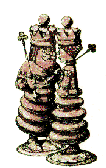...AFTER ALICE...

Charles Dodgson, aged about 40.
With the launch and immediately phenomenal success of Alice the story of the author's life becomes effectively divided in two: the continuing story of Dodgson's real life and the evolving myth surrounding his invented name "Lewis Carroll."
The bare facts of Carroll/Dodgson's last thirty years are clear enough.
Though apparently attracted and attractive to women (see below) he never married, and his emotional/sexual life is the aspect of his biography most enshrouded in controversy, misunderstanding, myth and mystery. Several 20th century biographers developed the idea that he wanted to marry Alice Liddell and a great deal has been made of this by writers of fiction and non-fiction alike, indeed it is a central image of Carroll's mythology. However there has never been any real evidence to support the idea and the 'new wave' of Carrollian analysis has called it into serious doubt, particularly since the discovery in 1996 of the 'cut pages in diary' document in the Dodgson family archive has re-shaped the debate in a major and surprising way.
His evident love for children, his enjoyment of their company as well as his usage of them as subjects for his photography is perhaps the most famous aspect of his biography. Unfortunately it is also the aspect most misunderstood and subsumed by myth. For years biographers believed he had no interest in adult society and that he 'rejected' his child friends after they reached puberty, and this led to many ideas that Dodgson was to some extent paedophilic. However recent analysis has claimed to show the idea of his exclusive attachment to small girls is at best a simplification and at worst a falsification. It is certainly true that, far from 'rejecting' his female friends once they reached puberty, Dodgson had a lifelong fascination with adult womanhood and enjoyed numerous friendships with women, some of which provoked a certain amount of gossip during his lifetime.
Dodgson remained at Christ Church
throughout his ever increasing wealth and fame, for the next thirty-six years.
His father's death in 1868 plunged him into a
depression that 'clouded' his life for some time,
little is known about why, though many theories abound.
He
published Through the Looking-Glass And What Alice
Found There in 1872, his great mock-epic The
 Hunting of the Snark, in
1876, and his last novel the two volume Sylvie and
Bruno in 1889 and
1893 respectively. He also published many mathematical
papers under his
own name, toured Russia and Europe on an extended
visit (in 1867). His journal of the trip was published years after his death.
Hunting of the Snark, in
1876, and his last novel the two volume Sylvie and
Bruno in 1889 and
1893 respectively. He also published many mathematical
papers under his
own name, toured Russia and Europe on an extended
visit (in 1867). His journal of the trip was published years after his death.
In 1881 he gave up the Mathematical Lectureship he had probably never much liked, and began a life of increasing leisure and some eccentricity. He became a member of the Society for Psychical Research at its inception in 1882, and an active campaigner against vivisection during the 1870s.

Dodgson aged about 60
In later life he became increasingly open about his 'unconventional' friendships with numerous girls and women, too old to be regarded as 'children' by the standards of his time. He would frequently entertain these women 'tete a tete' in his apartments at Christ Church, or holiday alone with them at Eastbourne. The absence of chaperonage on these occasions and other 'liberties' he took with the conventions of his time led to repeated rumour and gossip, which irritated him profoundly. His decision to give up photography in 1880 may have been connected with such rumours circulating at the time concerning his interest in photographing young women (in their late teens and twenties) in what he described as 'bathing dress', though there is no direct evidence to link this to his decision.
From 1869 he owned a house in Guildford, where he housed two maids, his six unmarried sisters and a seemingly ever-changing variety of nieces and nephews and other extended family. It was in a back bedroom of this teeming family home that he died, suddenly, of violent pneumonia, on January 14 1898, leaving enigma and an already burgeoning mythology behind him. He is buried in the Mount cemetary in Guildford.
Beyond these bare facts, there is a mass of uncertainty and even mystery. Until recently his life was believed to be completely understood, and to revolve around a few simple concepts such as 'pedophile', 'perpetual child', 'scholar-saint', 'innocent dreamer of children'. But we now know these clichés hid complex and contradictory truths that are only just being uncovered.
What - finally - is the reality of Lewis Carroll? This question is probably still waiting to be fully answered.
Biography compiled by the webmaster, © carrollmyth.com/lewiscarroll.cc .
NB:You are welcome to use this material under the stipulations of'fair use', but please cite the source.